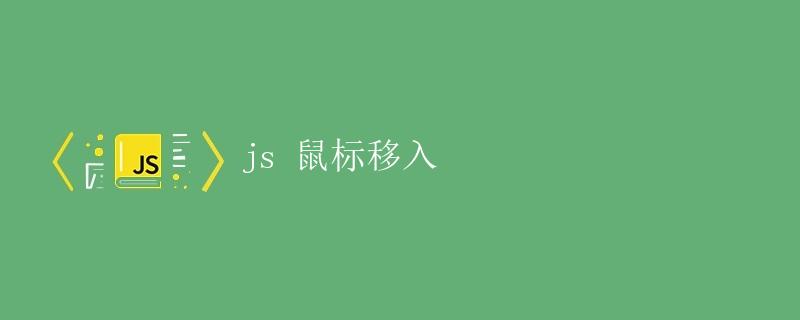JS鼠标移入

在网页开发中,经常会遇到需要对鼠标移入某个元素时触发事件的情况。通过JavaScript的事件监听器,我们可以很方便地实现鼠标移入时的交互效果。本文将详细介绍如何使用JavaScript来实现鼠标移入事件的监听,并提供一些示例代码和案例分析。
1. 基本概念
在JavaScript中,有一个名为mouseenter的事件,该事件表示鼠标移入元素时触发。与之类似的还有mouseover事件,但二者之间有一些细微的差异。mouseenter事件只在鼠标从元素外部移入到元素内部时触发,而mouseover事件会在鼠标移入元素内部的任何子元素时都会触发。因此,如果我们想要监听鼠标移入某个特定元素,最好使用mouseenter事件。
2. 监听鼠标移入事件
要监听鼠标移入某个元素,我们首先需要获取该元素的引用,然后使用addEventListener方法添加一个mouseenter事件监听器。下面是一个简单的示例:
// 获取需要监听的元素
const element = document.getElementById('targetElement');
// 添加鼠标移入事件监听器
element.addEventListener('mouseenter', function() {
// 鼠标移入时触发的操作
console.log('鼠标移入了元素');
});
在这个示例中,我们通过document.getElementById方法获取了id为targetElement的元素,并为其添加了一个mouseenter事件监听器。当鼠标移入该元素时,控制台会输出鼠标移入了元素这条信息。
3. 实际应用
3.1 改变样式
通过监听鼠标移入事件,我们可以实现一些交互效果,比如改变元素的样式。例如,当鼠标移入一个按钮时,按钮的背景色变为蓝色,文字颜色变为白色的效果。下面是一个示例代码:
<!DOCTYPE html>
<html lang="en">
<head>
<meta charset="UTF-8">
<meta http-equiv="X-UA-Compatible" content="IE=edge">
<meta name="viewport" content="width=device-width, initial-scale=1.0">
<title>Mouseenter Example</title>
<style>
button {
padding: 10px 20px;
background-color: #ff6347;
color: #fff;
border: none;
cursor: pointer;
}
</style>
</head>
<body>
<button id="btn">Hover Me</button>
<script>
const button = document.getElementById('btn');
button.addEventListener('mouseenter', function() {
button.style.backgroundColor = '#3498db';
button.style.color = '#fff';
});
button.addEventListener('mouseleave', function() {
button.style.backgroundColor = '#ff6347';
button.style.color = '#fff';
});
</script>
</body>
</html>
在这个示例中,我们监听了按钮的mouseenter事件,当鼠标移入按钮时,按钮的背景色会变为蓝色,文字颜色变为白色。同时,我们还监听了mouseleave事件,实现了鼠标移出按钮时恢复到原来样式的效果。
3.2 显示隐藏元素
另一个常见的应用是当鼠标移入一个元素时显示另一个隐藏的元素。例如,当鼠标移入图片时显示该图片的描述信息。下面是一个示例代码:
<!DOCTYPE html>
<html lang="en">
<head>
<meta charset="UTF-8">
<meta http-equiv="X-UA-Compatible" content="IE=edge">
<meta name="viewport" content="width=device-width, initial-scale=1.0">
<title>Mouseenter Example</title>
<style>
#image {
position: relative;
}
#description {
display: none;
position: absolute;
top: 10px;
left: 10px;
background-color: rgba(0, 0, 0, 0.5);
color: #fff;
padding: 5px;
}
</style>
</head>
<body>
<div id="image">
<img src="image.jpg" alt="Image">
<div id="description">Description of the image</div>
</div>
<script>
const image = document.getElementById('image');
const description = document.getElementById('description');
image.addEventListener('mouseenter', function() {
description.style.display = 'block';
});
image.addEventListener('mouseleave', function() {
description.style.display = 'none';
});
</script>
</body>
</html>
在这个示例中,当鼠标移入#image元素时,图片的描述信息会显示出来;当鼠标移出#image元素时,描述信息会隐藏起来。
4. 总结
通过JavaScript的事件监听器,我们可以方便地实现对鼠标移入事件的监听,从而实现各种各样的交互效果。在实际应用中,我们可以根据具体需求,结合CSS和JavaScript,创造出丰富的交互体验。
 极客笔记
极客笔记